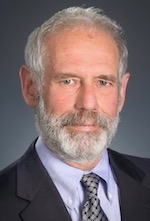Daily Business Report-Aug. 30, 2018
A solar photovoltaic system atop the 34-unit multifamily affordable housing Townspeople Apartments in San Diego provides 88 percent of its production to tenants. (Photo courtesy Center for Sustainable Energy)
Nonprofit partnership chosen to ensure
equitable access to solar energy for
California affordable housing
A team of leading clean energy and affordable housing organizations in California will run the state’s new Solar on Multifamily Affordable Housing (SOMAH) program. The California Public Utilities Commission initiative will provide up to $100 million annually for 10 years to fund solar energy installations on multifamily housing serving low-income and disadvantaged communities throughout the state, with a goal to help reduce energy bills for residents.
The SOMAH program administrator team includes the Center for Sustainable Energy based in San Diego, Association for Energy Affordability and GRID Alternatives, with implementation assistance from the California Housing Partnership Corporation, Rising Sun Energy Center and California Environmental Justice Alliance, among others.
“The idea behind SOMAH is to ensure equal access to solar energy for all California households, regardless of income levels,” said Benjamin Airth, a senior specialist in distributed energy resources at the Center for Sustainable Energy. “Low-income renters pay a higher percentage of their income on utility bills, and improving access to solar means lower bills, better housing security and a cleaner, healthier environment for all Californians.”
The SOMAH program was created by California Assembly Bill 693 to help California meet its climate goals, reduce energy bills for low-income residents and ensure that clean energy infrastructure isn’t just for the wealthy. The largest investment of its kind in the nation, it provides up to $1 billion over the next decade from five of the state’s investor-owned utilities’ greenhouse gas cap-and-trade auction proceeds to fully subsidize 300 megawatts of solar photovoltaic (PV) panels on affordable multifamily properties throughout the state by 2030.
___________________
Cubic wins contract to provide next-generation
transport management platform to Sydney
Cubic Transportation Systems has been awarded a $35 million contract by Transport for New South Wales to provide Sydney, Australia with one of the world’s most advanced transport management systems. The Intelligent Congestion Management Program (ICMP) contract is for a term of five years and seven months, with options for two three-year extensions.
The new system will enhance monitoring and management of the road network across New South Wales, coordinate the public transport network across all modes, improve management of clearways, planning of major events and improve incident clearance times, while providing real-time information and advice to the public about disruptions.
Cubic and its partners, including WSP, PTV Group, Mentz and Microsoft, will provide and support a technology platform integrating the operational management systems for all modes of transportation in the Sydney area, coupled with the most up-to-date data, statistics and intelligence on transport operations.
___________________
New national training program aims
to mainstream Glycosciences
Over the next five years, the National Heart, Lung, and Blood Institute, part of the National Institutes of Health, will award approximately $20 million to four academic centers to launch a new national Career Development Consortium for Excellence in Glycosciences:
• UC San Diego Program for Career Development in Glycosciences
• Johns Hopkins-Cleveland Clinic Program for Career Development in Glycosciences (Johns Hopkins University, Cleveland Clinic)
• BloodCenter of Wisconsin Program for Career Development in Glycosciences (BloodCenter of Wisconsin’s Blood Research Institute, Medical College of Wisconsin, Virginia Commonwealth University and Roswell Park Cancer Institute)
• Harvard Program for Career Development in Glycosciences (Harvard University)
As part of the consortium, University of California San Diego will receive approximately $5 million over five years for its own Program for Career Development in Glycosciences. UC San Diego was also chosen to lead the consortium’s national administrative coordinating unit.
___________________
Report: 80 percent of construction firms
have difficulty finding qualified workers
Eighty percent of construction firms report they are having a hard time filling hourly craft positions that represent the bulk of the construction workforce, according to the results of an industry-wide survey released today by Autodesk and the Associated General Contractors of America (AGC). Association officials said shortages pose a significant risk to future economic growth and they released a new workforce development plan to solve the growing problem.
Eighty percent of construction firms report they are having a hard time filling hourly craft positions that represent the bulk of the construction workforce, according to the results of an industry-wide survey released by Autodesk and the Associated General Contractors of America (AGC). Association officials said shortages pose a significant risk to future economic growth and they released a new workforce development plan to solve the growing problem.
Click here for the national survey results
___________________
Margo Turner named to National
Small Business Assn. Leadership Council

Margo Turner, president and CEO of Powerminds Inc., has been named to the National Small Business Association (NSBA) Leadership Council. NSBA is the nation’s oldest small-business advocacy organization, and operates on a nonpartisan basis.
Turner, a recognized leader in the small-business community, joins the NSBA Leadership Council alongside other small-business advocates from across the country as they work to promote the interests of small business to policymakers in Washington, D.C.
Turner is a serial entrepreneur, having launched and sold multiple successful enterprises, the largest employing 450 people in Southern California. She is a passionate advocate for positive change by creating solution environments. She credits her numerous teams for delivering on customer promises and raising their collective to shared success.
Turner joined the NSBA Leadership Council as part of his efforts to tackle the many critical issues facing small business, including tax reform, regulatory restraint, health care costs and how the Affordable Care Act will impact small business. The NSBA Leadership Council is focused on providing valuable networking between small-business advocates from across the country while ensuring small business a seat at the table as Congress and regulators take up key small-business proposals.
___________________
Defense Contracts
• R.E. Staite Engineering Inc., San Diego was awarded a $9,284,927 contract for maintenance dredging of Naval Weapons Station Harbor at Seal Beach, Calif. Bids were solicited via the Internet with two received. Estimated completion date is April 10, 2019. The U.S. Army Corps of Engineers, Los Angeles, is the contracting agency.
• Heffler Contracting Group Inc., El Cajon, was awarded a $15 million contract for heating, ventilation, and air conditioning alterations, renovations, and repair projects at Naval Base San Diego. The work to be performed provides for projects for design-bid-build (fully designed) task orders or task orders with minimal design effort (e.g. shop drawings). Projects may include, but are not limited to, alterations, repairs, and construction of heating, ventilation, and air conditioning systems and associated equipment. The term of the contract is not to exceed 60 months with an expected completion date of June 2023. The contract was competitively procured via the Navy Electronic Commerce Online website, with four proposals received. The Naval Facilities Engineering Command, Southwest, San Diego, was the contracting agency.
___________________
Miracle Babies receives a $20,000
donation from AMAG Pharmaceuticals
Miracle Babies, a nonprofit organization that provides financial and emotional support to families with critically ill newborns in the neonatal intensive care unit, has received a $20,000 donation from AMAG Pharmaceuticals as part of a partnership between the two. The two organizations will work together to enhance the well-being of women, children, and their families through education, risk reduction and assistance.
Miracle Babies was founded in 2010 by Dr. Sean Daneshmand, a maternal and fetal medicine specialist.
“We’re proud to support Miracle Babies as they continue to raise awareness about the difficult circumstances families with newborns in the NICU may face,” said Brian Robinson, M.D. senior vice president of medical affairs at AMAG Pharmaceuticals.
___________________
Personnel Announcements
Kimberly Stromberg joins Sycuan Casino

Sycuan Casino has named Kimberly Stromberg as the new director of rooms. In her new role, Stromberg will be responsible for leading and developing the Front Desk, VIP Lounge and concierge teams in anticipation of Sycuan’s upcoming hotel expansion.
As the director of rooms, she will be leading staff members to a shared commitment to creating positive guest experiences, modeling service standards and collaborating with other departments in order to enhance the overall guest experience.
Stromberg comes to Sycuan with over 10 years of hotel and casino operations experience at casino resort properties. Prior to joining Sycuan, she was the director of hotel operations at the Luxor Hotel & Casino in Las Vegas. During her time at Luxor, she oversaw front desk, front services, concierge, business center, spa, salon and pool operations.
Her other previous roles include assistant front desk manager, hotel operations manager and director of front office at the Mirage Hotel & Casino in Las Vegas.
___________________
Commentary:
My turn: Biomass electricity
isn’t cheap, won’t end wildfires
By Michael Picker, President, California PUC, Special to CALmatters

With California’s commitment to renewable energy and the growing concern about wildfires, biomass electrical generation is increasingly being promoted at the state Capitol as a tool for addressing both challenges as the legislative session is about to end. For a number of reasons, this approach has a lot to overcome.
A clean-energy policy has a different set of concerns than the issue of safety from wildfires. For clean energy, policymakers focus on emissions, price, and the ability of new resources to work together in ways that keep the lights on.
Fire safety revolves around reducing fuel, hardening communities to withstand ferocious fires and clearing vegetation from near electric lines. While these policies are not contradictory, there are obstacles to making them work in harmony.
There are 26 biomass plants in California that can generate enough electricity to power about 400,000 homes. These facilities rely on fuel sources ranging from agricultural waste to wood waste from lumber mills. Most of the plants are located near the fuel sources to reduce trucking costs. Many plants are not well suited to use fuel from high-risk fire areas since it is difficult to deliver sufficient fuel without incurring prohibitive costs, even if electric customers pay a premium for the energy.
After Gov. Jerry Brown’s 2015 “Tree Mortality Emergency” proclamation, California utilities entered into a number of biomass contracts. These were focused on forest waste that was sold at premium prices to account for the cost of obtaining the forest fuel and could generate enough electricity for more than 100,000 homes. But even with prices two to four times higher than solar or wind power, most of the facilities will struggle to obtain enough fuel.
Increased use of biomass faces other obstacles, too. New power plants far from customers would require new transmission lines. Small power lines that served remote areas in the Sierra forests don’t have the size and equipment to bring enough power to meet electrical needs hundreds of miles away. Building new power lines or upgrading existing ones to these biomass plants can cost millions of dollars.
Historically, biomass plants that burned forest waste were either owned by lumber mills or had entered into partnerships with them, but the California timber industry has shrunk. Now, public agencies such as the U.S. Forest Service are the major supplier of wood But with limited budgets to log and remove dead trees, not much progress has been made in reducing fire fuel.
The governor’s interagency Forest Management Task Force is coordinating a study to identify and assess barriers to wider use of fuels from high-risk areas. But the current level of forest activities probably isn’t enough to supply biomass facilities with an economically viable flow of fuel from high-hazard areas and is insufficient to meet forest management needs within those same fire-prone regions.
Building a new sustainable forestry industry in the Sierra and Siskiyou mountains could make biomass facilities more effective as part of a whole array of fire prevention tools, as well as offering jobs and economic development in those communities.
But on its own, biomass is a limited fire prevention tool and will require extensive ratepayer subsidies. Even with subsidies, biomass may not work as an effective fire-prevention tool outside pine forests.
It seems clear that if we’re counting on biomass electricity generators to significantly reduce the number and ferocity of fires, we’ll fall short. If we expect these generators to help with carbon reduction, we’ll also fall short. And if we overbuild these plants to provide more electricity, we’ll overshoot our demand for what customers need.
Simple solutions to complex issues often sound good at first but may look unwise in hindsight. If there is a role for biomass in mitigating against more destructive wildfires, it’s only part of a much larger firefighting and sustainable forestry strategy.
Michael Picker is president of the California Public Utilities Commission, Michael.picker@cpuc.ca.gov. He wrote this commentary for CALmatters.



